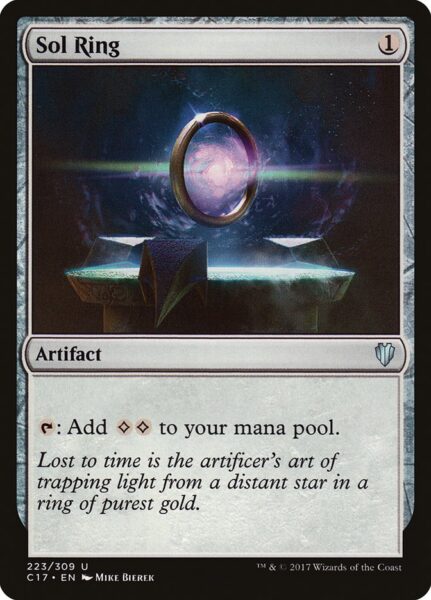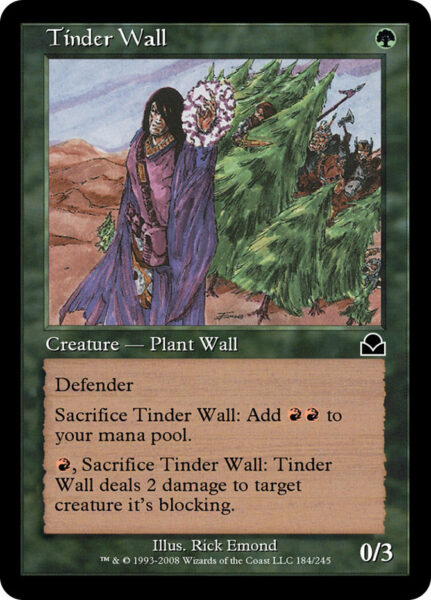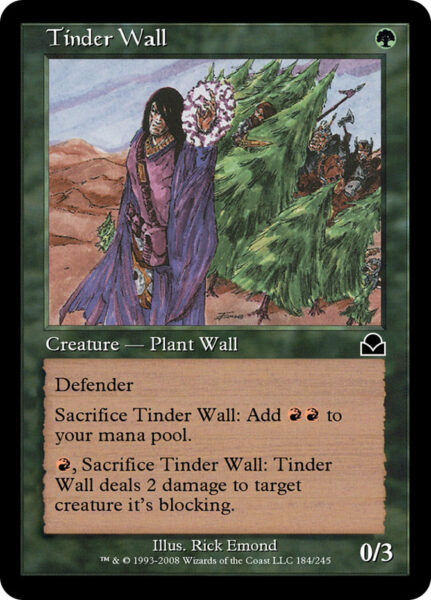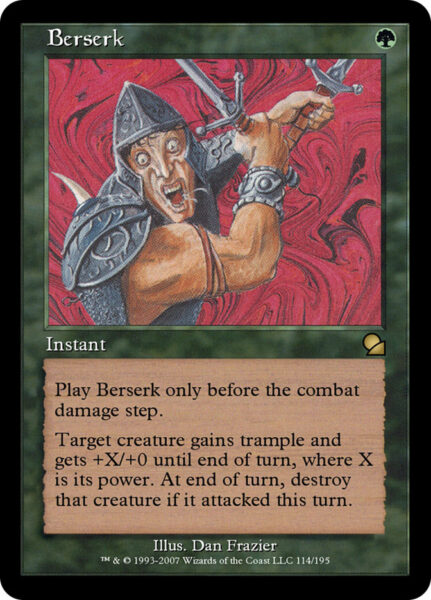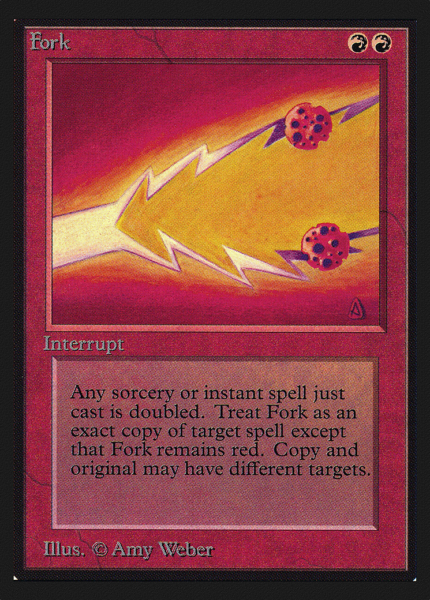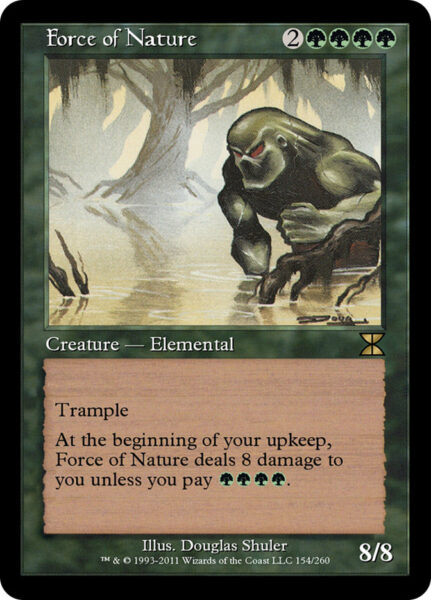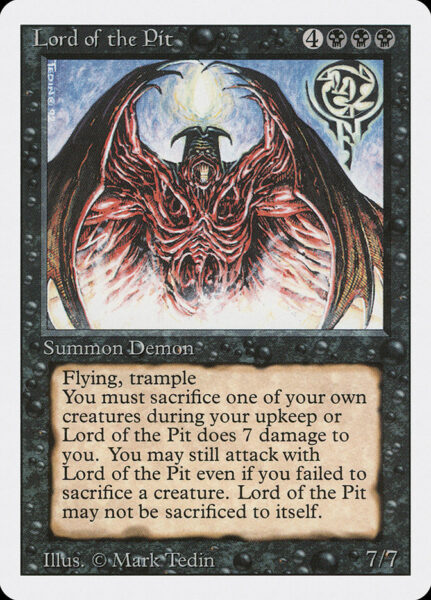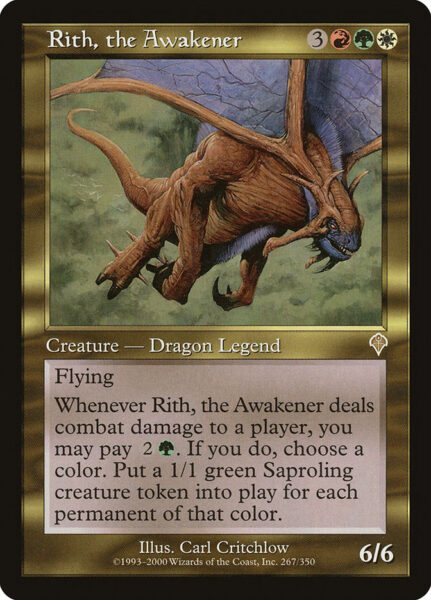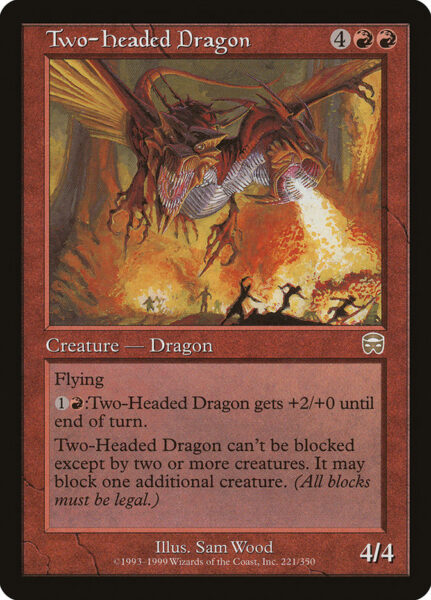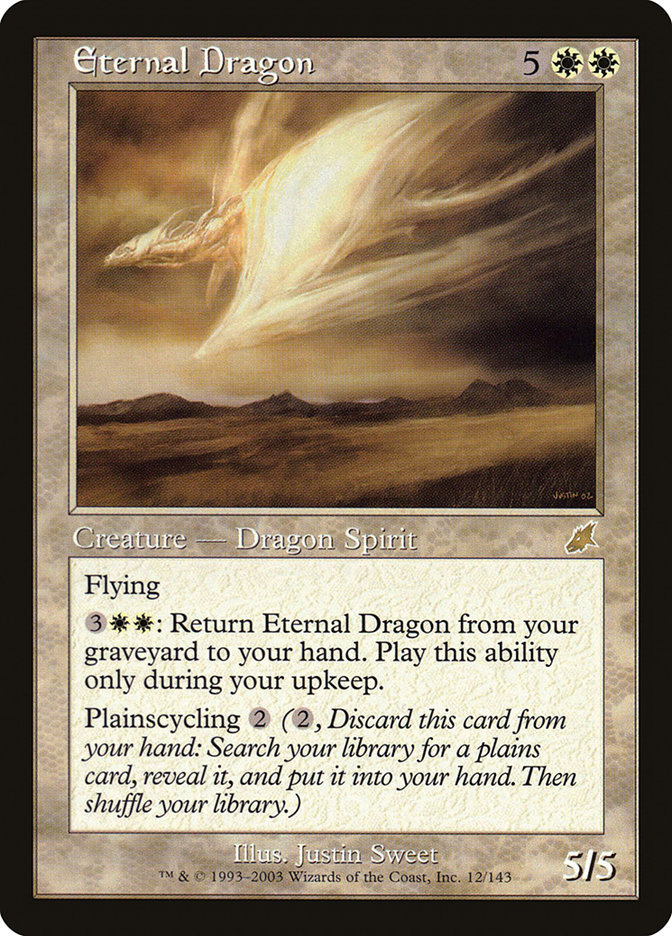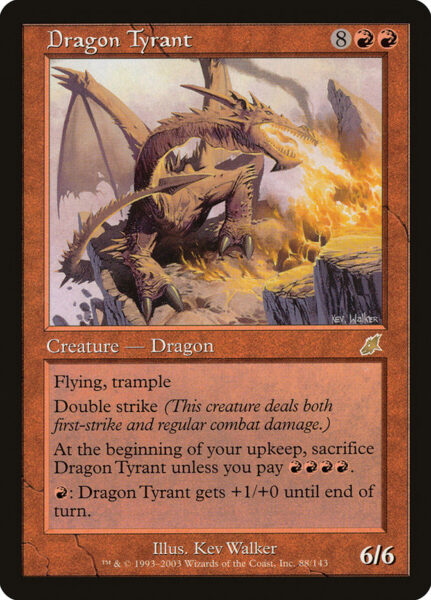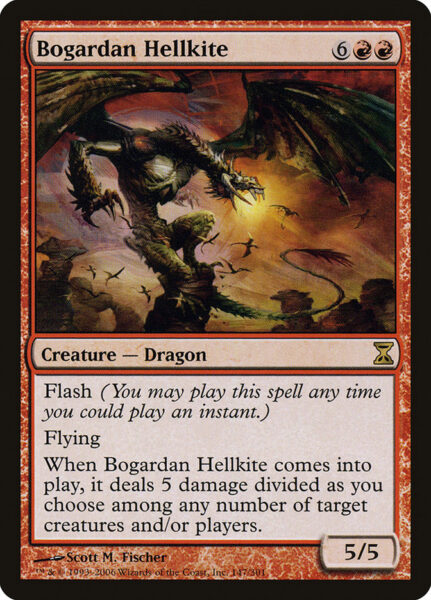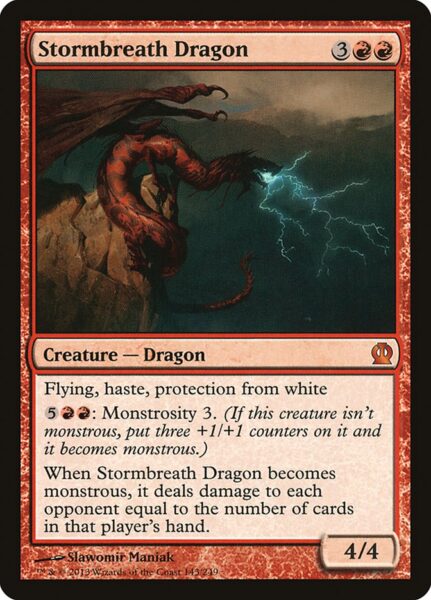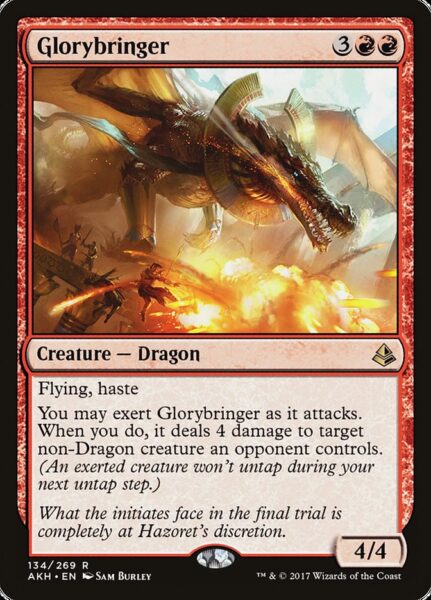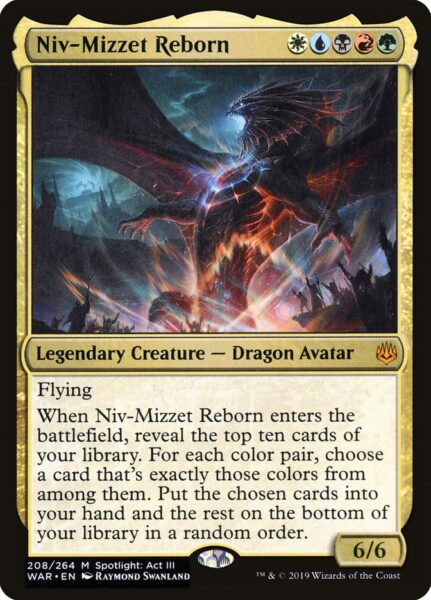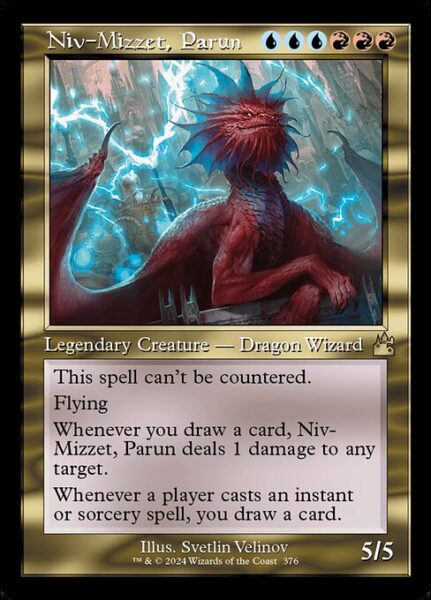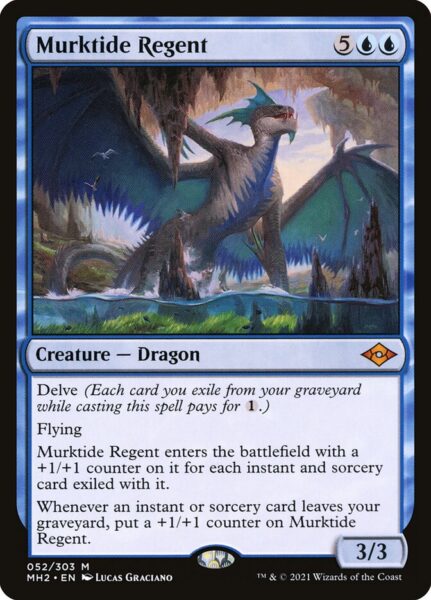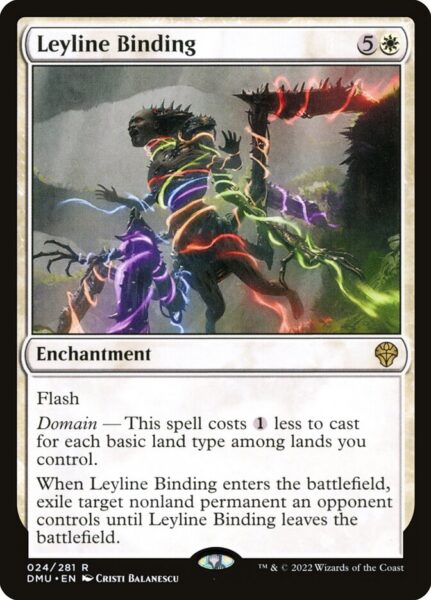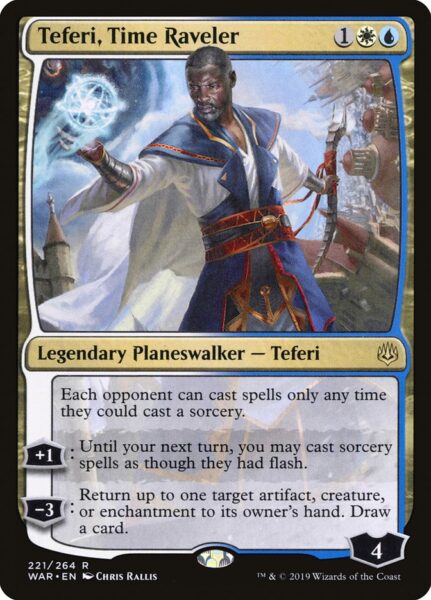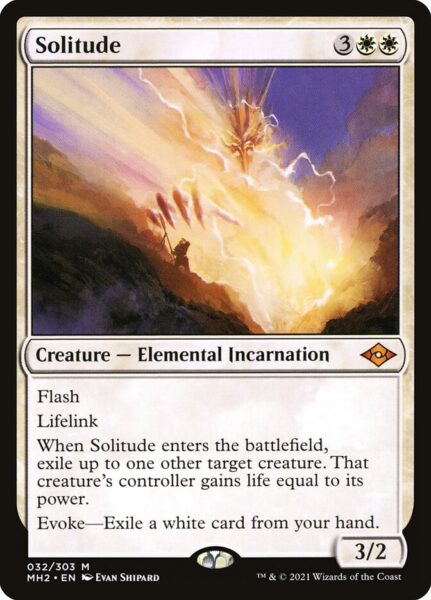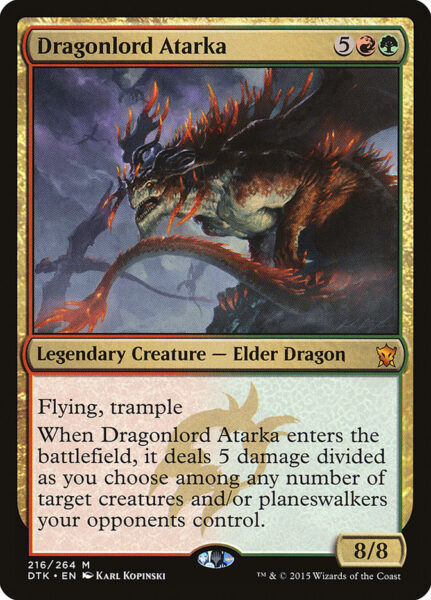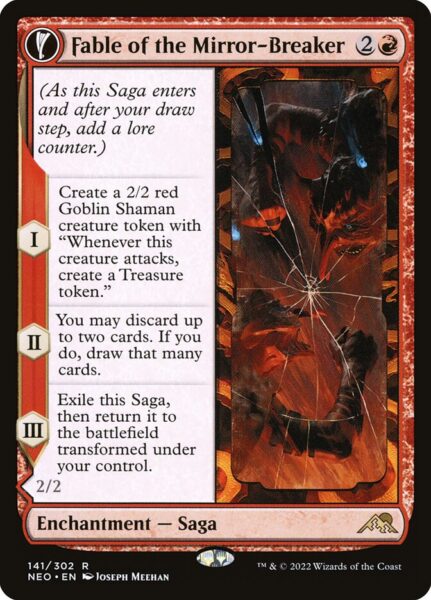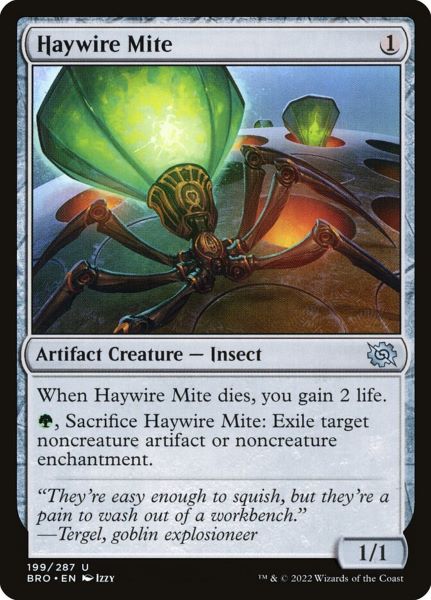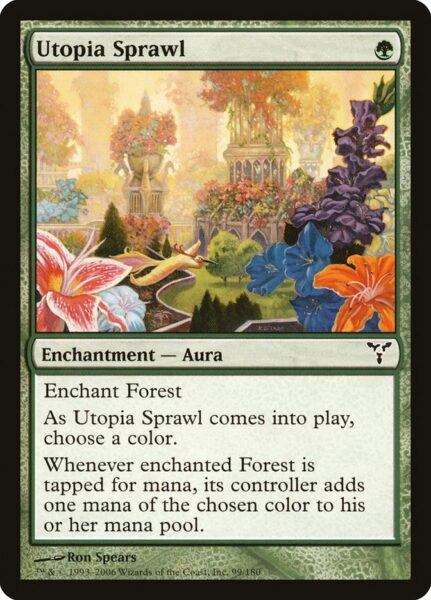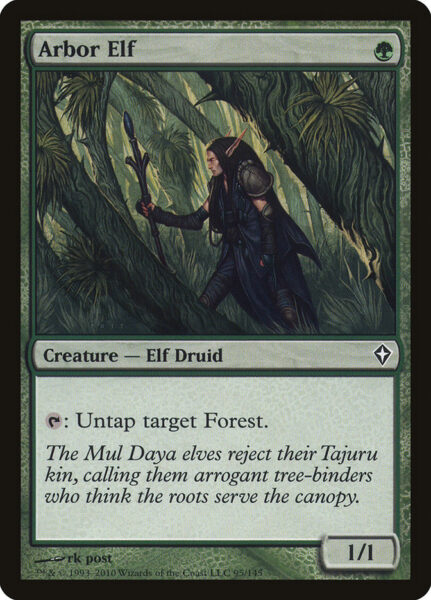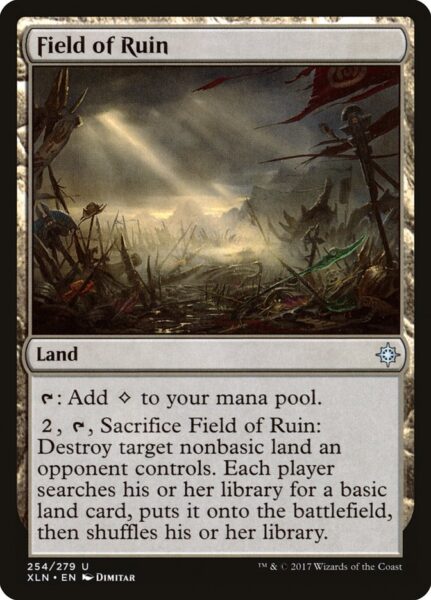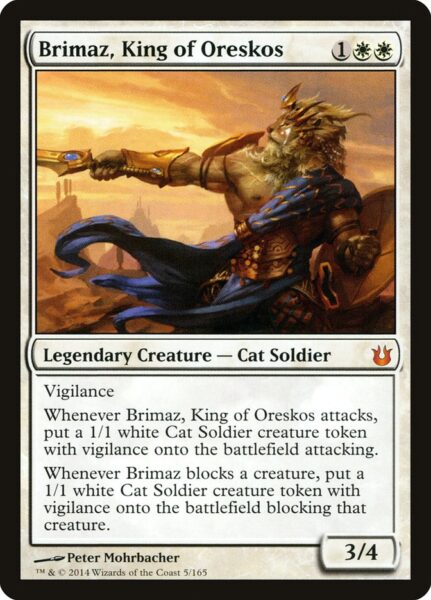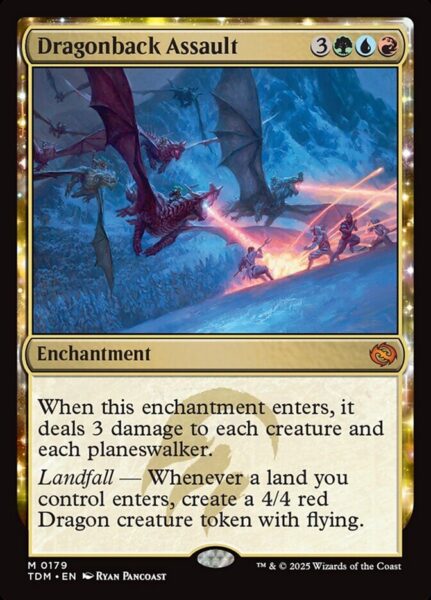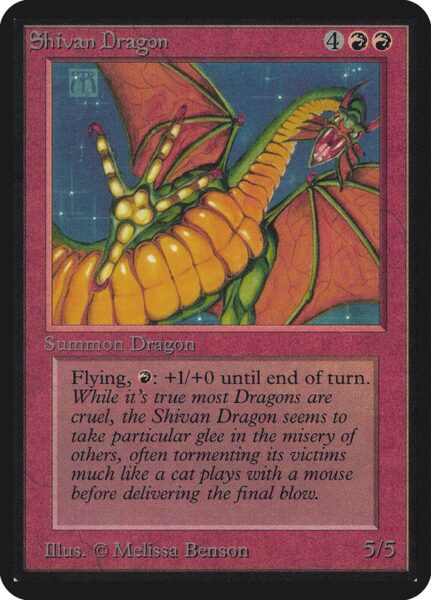
I’ve loved beating down with dragons since I began playing Magic in the early 90s. Back then, Shivan Dragon was the biggest and baddest (and most playable) of them all. My first play deck (as we used to call our primary deck) sought to abuse Gauntlet of Might with the iconic fire-breathing ability of the massive 5/5 flier. I even had a combo that could kill an opponent as early as turn 3 using two copies of a common from Ice Age, Tinder Wall and a turn 1 Sol Ring to cast a Shivan Dragon on turn 2. Berserk plus Fork on turn 3 let me hit for 20.
6-card combo…totally playable!
In the 90s, that wasn’t bad for a creature deck. The likes of Ragavan, Nimble Pilferer, Uro, Nature’s Wrath, and Murktide Regent were decades away. This was the heyday of instants and sorceries, powerful-to-busted non-creature spells that could control a game for what felt like an eternity. 6 mana for a 5/5 flying dragon whose power could be pumped were actually good stats in the early days of Magic. More often than not, powerful creatures had drawbacks to offset their strengths, either in the form of extremely high mana costs or some other negative effect, like sacrificing a permanent or paying mana each turn (think Force of Nature or Lord of the Pit). Shivan Dragon was one of a handful of early creatures with little to no drawback, though a 6-mana creature with those abilities in today’s Magic would be considered unplayable. Serra Angel and Sengir Vampire were two other creatures whose stats would be considered decent in today’s Magic and who didn’t come with a drawback. Interestingly enough, they were both uncommons and, with Serra Angel, saw more play than the rare dragon.
Which of these are playable?
A Brief History of Dragons
For a long time, Wizards continued the trend of printing dragons with powerful stats but at either a too-high mana cost or with some other drawback that made them largely unplayable. The iconic Nicol Bolas from Legends had both, costing 8 mana of three different colors and requiring an upkeep cost of 3 mana each turn. In 1999, a more playable 6-mana dragon was printed, Two-Headed Dragon, but its stats are still worse than the OG Shivan Dragon. It did see play in at least one deck that did well at Worlds as a top-end threat for a Fires of Yavimaya Gruul deck.
Invasion, released in 2000, saw the printing of a cycle of legendary dragons, all of which cost 6 mana and are 3 colors. Each comes with the ability to pay 3 mana for an effect if the dragon deals combat damage to a player. Rith, the Awakener saw play as a 1-of at the same Worlds tournament in a similar Fires of Yavimaya Gruul deck as the one Two-Headed Dragon made an appearance in.
And thus goes the story of almost all dragons Wizards printed for more than a decade. Overcosted, but often very powerful, if a dragon saw play in a competitive deck, it was usually as a 1-of. Some notable exceptions to this were Eternal Dragon, which saw play in a successful control deck, largely because you could cycle it away and then return it to your hand; Covetous Dragon, which was played in a deck with 32 artifacts at a time when Grim Monolith and Cursed Scroll were legal; and Bogardan Hellkite, which was the payoff in a combo deck looking to cheat it into play. More emblematic of the kinds of dragons Wizards printed during the first 15 years of Magic is Dragon Tyrant, released in May 2003 in Scourge. It costs a whopping 10 mana and also requires edededed during each upkeep to keep alive.
Two of these three actually saw competitive play.
When Dragons Became Playable
Things changed with the printing of Thundermaw Hellkite in Core Set 2013 thanks to one key word – haste. Dying to Doom Blade, regardless of the logic of such a statement, is a thing when you invest 5 or 6 mana into a giant creature that doesn’t do anything until you untap. Wizards solved this problem with this one little key word. But they didn’t stop there. Thundermaw Hellkite is arguably the most pushed dragon ever printed. There hasn’t been another 5/5 dragon with haste for 5 mana printed since. And, in case this wasn’t enough, it also has an enter-the-battlefield (ETB) effect that gives you additional value, even if it is immediately killed. It should be noted that other dragons in Magic’s history had haste, but they were so overcosted as to be laughable (see Brimstone Dragon from Portal Second Age, released in 1998).
After Thundermaw Hellkite came another very pushed dragon – Stormbreath Dragon – and another new trend for the tribe – 5 mana for a 4/4, rather than a 5/5. Stormbreath Dragon also comes with protection from white, making it a powerful choice for Modern players, where Path to Exile was a premier removal spell at the time (and Solitude is now). Being able to monstrous is another plus that continued to reverse the trend of overcosted and unplayable dragons. We now had two very powerful options.
The trinity of Dragons.
The third dragon Wizards printed that was competitively costed was Glorybringer from Amonkhet, which was released in 2017. Another hasty 4/4 flier with an additional ability, Glorybringer rounded out the trinity of 5-mana dragons I played in my first Modern dragons deck. Exert is a powerful and unique ability that is also a flavor win. Every other turn, Glorybringer gets to burn something with its fire breath.
Ever since the release of Thundermaw Hellkite, Wizards has printed more and more playable dragons, ranging from the dragonlords of Dragons of Tarkir (2015) to the various iterations of Niv-Mizzet that showed up in both Standard and many eternal formats. In fact, Niv-Mizzet Reborn is the only dragon to see play in a tier 1(ish) deck in Modern up until the printing of Murktide Regent, the namesake card of one of Modern’s best decks.
Leave it to Modern Horizons II to print the most playable dragon in Magic…and make it busted.
Let’s take a moment here to compare two of the dragons from Modern Horizons II. Murktide Regent needs no introduction or explanation as to why it is so powerful. It was designed (and pushed) to go in a deck full of cheap cantrips and interactions and quickly found a home as the big finisher in Izzet Murktide (be on the lookout for an Izzet Dragon deck on this site in the near future). Even without the last line of text, this card would be extremely powerful. The biggest problem with this card is that it’s mono blue! Why give blue the best dragon in the set and not red, the color most associated with dragons in the history of Magic?
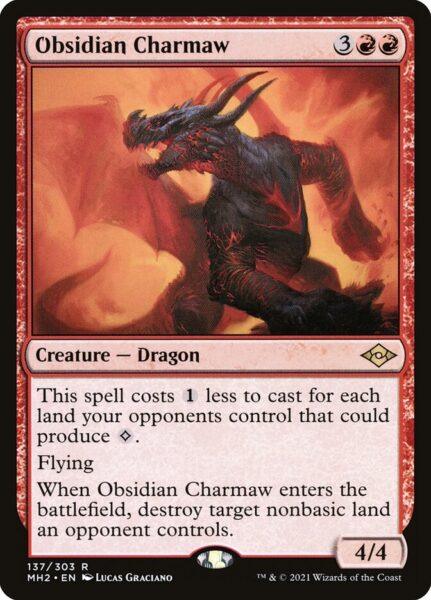
To add insult to injury to those of us who want to play dragons in Modern is Wizards did print a red dragon in MH2, but nerfed it to the point of unplayability: Obsidian Charmaw. This card would’ve helped dragon decks immensely had two things been different. First, instead of reducing the mana cost of the spell based on colorless producing lands, reduce it based on nonbasic lands. Second, and perhaps in combination with the first, the card would’ve been too pushed, give it haste! With these stats, plus its land destruction, I could see Obsidian Charmaw being a mythic and costing 6 mana, but it still would’ve been great for dragon decks in Modern.
Which leads me to the point of all this – DRAGONS IN MODERN!!!
That’s right. I’ve built several different dragon decks for Modern, the best of which I’ll post articles about on this site, if I haven’t done so already. I won’t start with the first deck I built, which was Rakdos dragons, but rather with the latest version of the deck I’ve had the most success with. However, be on the lookout for articles detailing that Rakdos decklist and others. My plan is to build, play, and discuss dragons in all the various color combinations, because, well, I love dragons and they need a representative in competitive play!
Decklist – Gruul Dragons
by Johnny Cycles
Format: Modern
Creatures (18)
| 4 Arbor Elf | |
| 2 Ignoble Hierarch | |
| 3 Questing Beast | |
| 4 Glorybringer | |
| 4 Stormbreath Dragon | |
| 1 Thundermaw Hellkite |
Planeswalkers (11)
| 3 Wrenn and Six | |
| 4 Domri, Anarch of Bolas | |
| 4 Kiora, Behemoth Beckoner |
Spells (4)
| 4 Lightning Bolt |
Enchantments (4)
| 4 Utopia Sprawl |
Lands (23)
| 1 Boseiju, Who Endures | |
| 4 Field of Ruin | |
| 6 Forest | |
| 3 Mountain | |
| 1 Sokenzan, Crucible of Defiance | |
| 4 Stomping Ground | |
| 4 Wooded Foothills |
Sideboard (15)
| 3 Tamiyo’s Safekeeping | |
| 2 Veil of Summer | |
| 3 Chalice of the Void | |
| 2 Brotherhood’s End | |
| 3 Endurance | |
| 2 Force of Vigor |
Primary Game Plan
Our goal is to cast a dragon on turn 3, ideally by playing a turn 1 mana dork, followed by a turn 2 Planeswalker. You may be saying that Modern is a turn 3 format; dragons will never be tier 1. Well, you are correct, but they sure are fun to play and, despite the overall speed of the format, surprisingly competitive. So, if you’re here to pick up a new deck that can 5-0 leagues on a regular basis, this article isn’t for you, but you probably already know that. If you want to play a deck that has surprisingly fun board states (think Kiora, Behemoth Beckoner and Wrenn and Six on turn 2) and sweet lines of play (followed up by Glorybringer that draws you a card, kills an opponent’s best threat, hits for 4, and then gets untapped by Kiora on the next turn to kill their next threat), then this deck is for you.
Ideal Hand
Arbor Elf and Utopia Sprawl is the most powerful 2-card combo in Modern for midrange decks looking to keep up with the fast, true combo decks (though the recent success of the Scam deck using Grief plus Feign Death has a compelling case, too). We aren’t looking to abuse these two cards with an abundance of 4 drops, though we could (more on that later), but a turn 2 Questing Beast is a thing and probably our most aggressive start, particularly if we follow that up with a turn 3 dragon.

Kiora, Behemoth Beckoner gives us another untap effect that allows us to produce a ton of mana if we untap with all three cards. From there, we want to cast at least one of our 12 finishers and hope to draw into more action from Kiora’s static ability. One more thing about Kiora, Behemoth Beckoner: to paraphrase The Big Lebowski, she is the rug that ties the deck together. She does everything we want – ramps us, draws us cards, and gives us a repeatable means of killing a threat, all while starting out with an insane amount of loyalty. The deck plays at its best with a turn 2 Kiora.
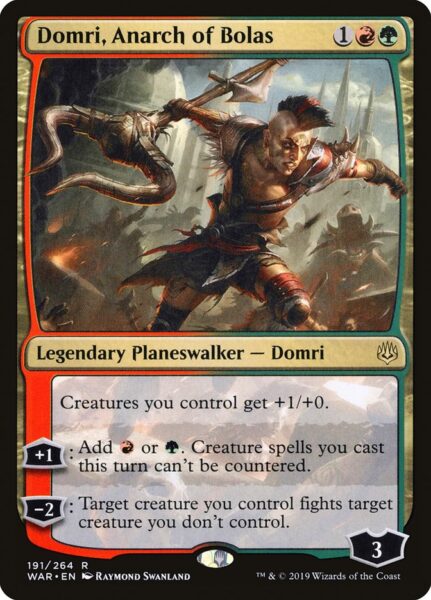
However, if we are playing against control, our best turn 2 play is Domri, Anarch of Bolas, as it makes our creatures uncounterable. But don’t think he’s only good against counter-magic decks. His static ability gives us a faster clock, which, in combination with Ignoble Hierarch’s exalt trigger, will frequently let us hit for 6 damage a turn with a single one of our finishers. Domri’s -2 provides us with some much-needed removal, though we have a surprising number of ways to deal with creatures, even though at first glance it looks like all we have is Lightning Bolt (more on this later).
By turn 3, we want to start casting our finishers, most of which are big, bad, flying fire-breathing dragons. Questing Beast may seem like an odd choice in a dragon deck (at the time of this writing, The One Ring hadn’t yet been spoiled or printed, much less the dominant force it now is in Modern), but the reasons for including it are many (and are now one more). First, the card gives us the rare turn-2 4-drop and, even if we aren’t a 4-drop tribal deck, we want some number of these to fill out our curve. Second, it synergizes well with Kiora, Behemoth Beckoner, in that it draws us a card from her static ability.
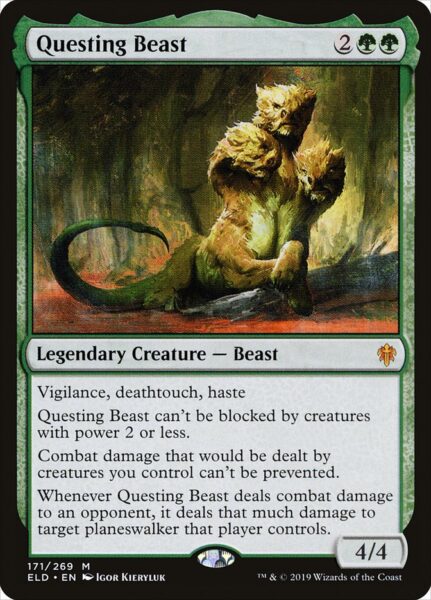
Third, the card is amazing, plain and simple. It’s a sign of the power level of Throne of Eldraine that Questing Beast isn’t the most busted card from the set. More specifically, its haste and semi-evasion are exactly where we want to be with our dragons and there hasn’t yet been printed a comparable 4-drop dragon for this slot (Atsushi, the Blazing Sky and the recently printed Decadent Dragon are great, but lack that most important of words…haste). Its ability to pressure our opponent’s life total while simultaneously killing Planeswalkers is a real benefit in today’s Modern. Vigilance and deathtouch make it an insane blocker and a great fight target for our Domri, Anarch of Bolas to deal with bigger threats, such as Murktide Regent or Primeval Titan. Its chief drawback is that it dies to Fatal Push, whereas our bigger threats do not, but all its upside makes the card bonkers. With the recent dominance of The One Ring, its ability to stop damage prevention is perhaps now its greatest draw.
Glorybringer offers our deck the hasty beater we want while sniping most of the threats our opponents are playing. Kiora, Behemoth Beckoner gets to untap our exerted dragon every turn, which makes the card truly amazing. More than one opponent has scooped upon realizing whatever they cast will just get killed every turn by this 2-card combo. With bigger threats, we can exert Glorybringer and after combat use Domri’s fight ability to finish it off. Yes, we will lose our dragon, but compared to leaving a Primeval Titan unchecked, this is preferable.
Stormbreath Dragon gives us a finisher that dodges some of the best removal in the format right now. While Path to Exile is no longer the premier white removal spell, this is largely because other white removal spells have replaced it. Whether it’s Prismatic Ending, the recently printed Leyline Binding and Solitude, or the broken 3-drop Teferi, Time Raveler, Stormbreath Dragon presents an unanswerable threat that, coupled with its monstrous ability, can close a game out extremely quickly.
“Wait, are these cards good?” – Stormbreath Dragon
The one-of, fun-of Thundermaw Hellkite is not just a shout-out to the best dragon ever printed. It both hits harder than our other finishers, and gives us an ETB ability that deals with the kinds of decks that can give us trouble by flooding the board with fliers of their own (think U/W Spirits or the tokens from Lingering Souls). Neither Spirits nor B/W midrange are at the top of the format, but both see enough play that Thundermaw Hellkite will give us the kinds of blowouts that keep it in the deck. Not to mention its ETB effect taps down the creatures it deals damage to, so even if it’s highly, highly unlikely it will kill a Murktide Regent, Thundermaw Hellkite will keep it (and those pesky Ledger Shredders) from blocking the turn it enters the battlefield.
Removal
Lightning Bolt gives us an efficient, instant-speed answer to smaller problem threats, as well as some reach to close out a game if our opponent has stabilized after taking their beats. However, the card also gives us flexibility with the many other ways we have of dealing damage. Exerting a Glorybringer to hit a Primeval Titan isn’t enough without help. Lightning Bolt finishes the job.
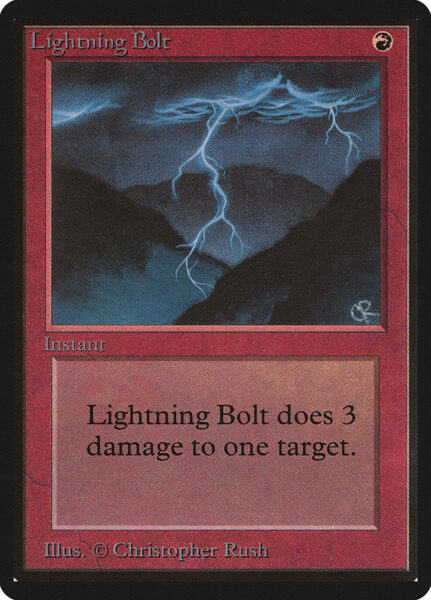
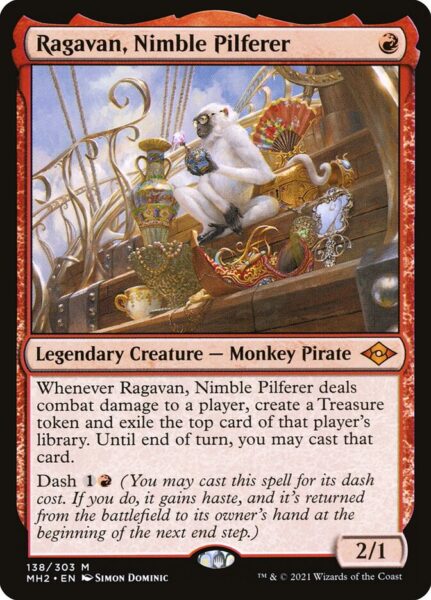
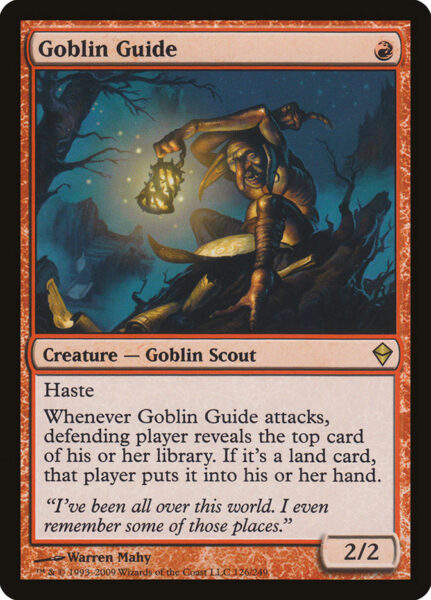
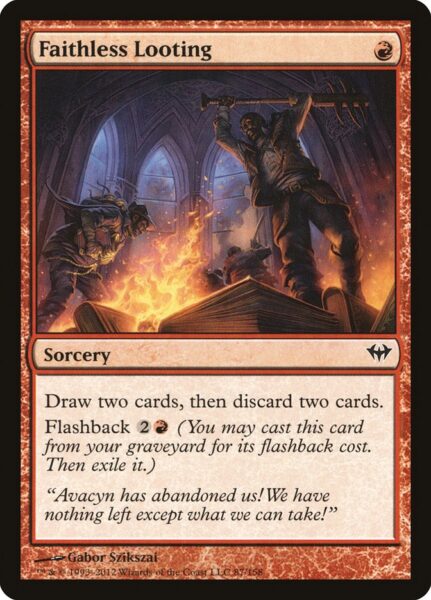
Wrenn and Six snipes Ragavan, Nimble Pilferer and pre-delirium Dragon-Rage Channeler, not to mention opposing deck’s mana dorks. It also lets us recur Field of Ruin and Boseiju, Who Endures to attack our opponent’s mana or, with the latter, answer popular hate cards, such as Leyline Binding and powerful enablers, such as Amulet of Vigor. I’ve recently increased the number from 2 to 3 copies, as the 2-mana Planeswalker ensures we make our land drops, while also frequently drawing out a kill spell or soaking up some combat damage. We are a slow deck (in Modern terms), but we can finish fast, so we just need to live until turns 5 or 6.

Domri, Anarch of Bolas is one of our best kill cards, as mentioned above. It gives us a recurring means of answering our opponent’s threats, while pumping our creatures to ensure they do more damage in the fight. Couple Domri’s static ability with an exalted trigger from Ignoble Hierarch, and suddenly our 4/4 dragons are dealing 6 damage in a fight (after combat), which is enough to kill most of the biggest threats in the format. This synergy is so powerful that I’ve played all 8 Hierarchs as my mana ramp, eschewing the Arbor Elf–Utopia Sprawl combo in favor of more exalted triggers, more damage, and this added bonus of being able to kill bigger creatures. I’m still about 60-40 in favor of the mana ramp in this deck over 8 Hierarchs plus Utopia Sprawl, but if you want to pick up the deck, I recommend trying out both to see what suits you.
Other Dragons
The trinity of dragons I’ve chosen for this build are no longer the most obvious choices. Thankfully, Wizards continues to print playable and unique dragons at the 5-mana slot. As you will see in subsequent articles, I play some of them in my different dragon decks. For example, Goldspan Dragon gets the nod in my Izzet dragon deck and could certainly be played in the above deck, as well.
A totally playable 2-card combo in Modern…
Terror of the Peaks is another powerful dragon that deserves some testing. As of this writing, I have not yet tried the Core Set 2021 mythic in Modern, largely because it doesn’t have haste and feels a little like a win-more card, but I’m definitely curious. The lack of haste is ameliorated somewhat by its having ward (before ward was a thing), ensuring our opponent will likely lose at least 3 life if they kill it before we attack. If we untap with it and play a finisher…watch out, that should be game over. For these reasons, I do think it deserves playtesting. I can see trying it out in a build that features another powerful dragon that deserves consideration in this deck – Dragonlord Atarka.
Finally, a card I’m excited to try out in this build is Shivan Devastator. We can cast it as a hasty flying 4/4 on turn 3, like our other dragons, but it comes with the added bonus of scaling up in power as the game goes long. One of the drawbacks of this deck is we flood out more than the average deck, given that we play 10 mana dorks (including Utopia Sprawl). If we’ve reached 9, 10, or 11 mana in the mid- to late-game, then topdecking this dragon hydra can be game ending. Dying to Fatal Push is a thing, of course, but the risk may be worth the reward.
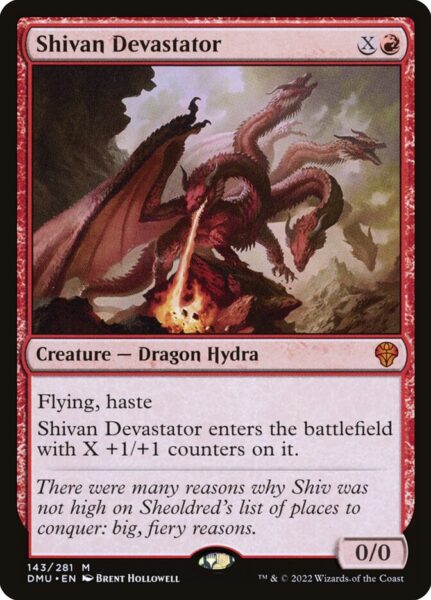
Cards to Consider for the Main Deck
Blood Moon is the most obvious card deserving of consideration for the main deck. Many of Modern’s best decks have greedy mana bases that can be easily punished in game 1 with Blood Moon. 4-color Money Pile, Primeval Titan decks, Infect, Tron, and many control strategies will be max punished with a turn 2 (or turn 3) Blood Moon in game 1. Even a deck like Hammer Time will suffer once their Urza’s Saga and Inkmoth Nexus are basic mountains.
If you choose to maindeck Blood Moon, and I think in a Rakdos build this would be a no-brainer, then another card I would definitely include is Fable of the Mirror Breaker. The saga from Kamigawa: Neon Dynasty needs no introduction for anyone who has been playing Magic this past year (2022). The card would do a lot for our Gruul build of dragons that warrants some play testing with it, as well. It gives us some conditional ramp, while also allowing us to filter our hand, discarding an unneeded mana dork or second copy of a Planeswalker to dig for action. Once flipped, it can copy any of our dragons, since none are legendary.
Making room for an additional 7 or 8 3-drops in this Gruul build would mean cutting two of our three Planeswalkers. I’m not sure it’s worth it, to be honest. I can see cutting Wrenn and Six and maybe a Hierarch to make room for a playset of either of these cards, but it needs testing.
Another obvious card for consideration is Ragavan, Nimble Pilferer. Any deck playing red has to have a good reason not to play the stupid monkey, and I’ll share a build of this deck that includes the most busted 1-drop creature in the history of Magic below. The short version of my opinion of Ragavan is that it will either run away with the game or draw out a kill spell that will allow one of our mana dorks or late-game threats to survive. The card is broken and definitely deserves consideration.
Finally, in the earliest builds of this deck (before the printing of Questing Beast), I played two copies of Chandra, Torch of Defiance. Living the dream of playing her on turn 2 meant she either sniped an early threat or ramped us into our finishers on the way to a quick ultimate. She deserves consideration, even if she is a little too slow in today’s Modern. I have a spicy Gruul Super Friends deck that runs her.
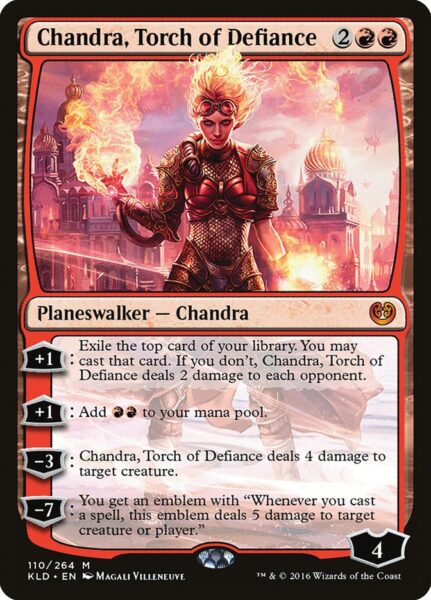
Sideboard
As with any deck, the sideboard is largely dependent on the meta. However, we are a turn 5ish deck (sometimes we can win by turn 4, other times turn 6 or 7), so we want to have hate against the fast, unfair decks. Force of Vigor slows down Hammer Time or gets us back a threat from Leyline Binding. Endurance hates on graveyard, mill, and cycling decks, while serving as an early game blocker against Burn. It also slows down Izzet Murktide, while protecting our finishers, as it can turn off our most hated card, Unholy Heat. Chalice of the Void may seem like an odd choice in a deck that plays so many 1-drops. However, on the play, a turn 2 Chalice, after we’ve played 2 of our own 1 drops, will be enough to slow down many of Modern’s best decks long enough for us to beat down with our dragons. Most opponents won’t see it coming, either, and so won’t have boarded in their own answers. It also gives us some much needed hate against the Cascade decks.

Veil of Summer is a necessary evil against Thoughtseize, while sometimes allowing us to play into counterspells, assuming our Domri isn’t on the battlefield. Brotherhood’s End gives us a sweeper against go-wide decks and a powerful answer to Hammer Time and the Affinity decks that crop up from time to time. The 3 damage it does hits all creatures and Planeswalkers, though, so there will be times when we hurt ourselves as much as our opponent, so be careful.
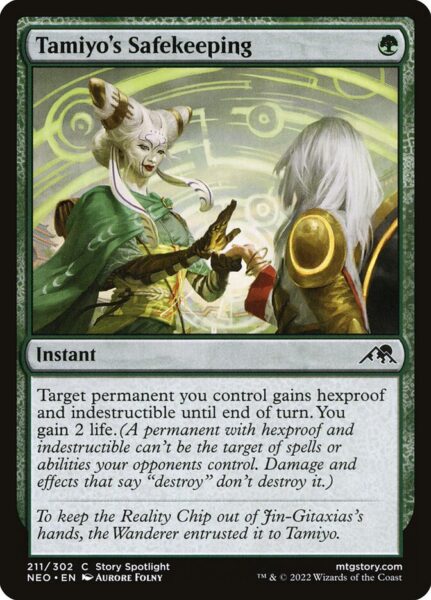
Tamiyo’s Safekeeping is probably the strangest of all the sideboard cards and its inclusion is to fight against Unholy Heat and any other kill cards our opponents may board in. Unholy Heat is one of the main reasons more midrange decks aren’t played in Modern. A 1-mana spell that answers a 6-power creature or 6-loyalty Planeswalker is an abomination. Yes, this is only the case if the caster has delirium, but since drawing cards and filling the graveyard is essentially the main game plan of the Murktide decks, this hardly functions as a drawback. Other decks will bring in more targeted removal or sweepers, and Tamiyo’s Safekeeping will help keep our best threat alive. And in case you forgot the first rule in Magic, which we all do from time to time, it says “Target permanent.” Most green spells that give hexproof or indestructible can only target creatures (like Tyvar’s Stand, for instance). While we will typically use this spell to keep one of our dragons alive, there will be times when protecting a Planeswalker is our best play. This card gives us that flexibility. Note, however, that indestructible will not prevent combat damage from removing counters from a Planeswalker…not that I learned this the hard way or anything. We also bring it in against Burn. Fizzling a burn spell on one of our mana dorks, while also gaining us 2 life is often enough to keep us ahead on board and life total.
Blood Moon and Fable of the Mirror Breaker are two cards that could easily be included in the sideboard. Both would shore up some of our bad matchups, either by attacking mana bases or by drawing us cards. Fury is another card that would help against creature-heavy decks while not watering down our own suite of threats. Finally, as I edit this article, The One Ring is ruling Modern. Force of Vigor is suddenly a dead draw against the best card in the format. We need exile effects, and two cards immediately come to mind: Haywire Mite and Cast into the Fire.
Haywire Mite has to be on the battlefield to be used at instant speed, which is a drawback. Its lifegain and ability to chump block are both benefits against decks like Burn. Cast into the Fire is an obvious flavor win to bring in against The One Ring, but it also gives us some nice additional removal against Murktide decks. Sniping both a Ragavan, Nimble Pilferer and a Dragon-Rage Channeler with this feels like a blowout.
Problem Cards
If the sideboard didn’t clue you in, hand disruption and cheap removal are two of our biggest challenges. Getting our one dragon in a mull to 6 plucked from our hand by a Thoughtseize leaves us topdecking. Similarly, spending 2 turns ramping into a 5-drop, only to see it killed with a 1-mana spell before we go to combat is very disheartening. We lack true card draw, which is one reason Kiora, Behemoth Beckoner is so crucial to our deck, so it’s easier for us to flood out or draw non-impactful cards in the late game, making our opening hand that much more important.
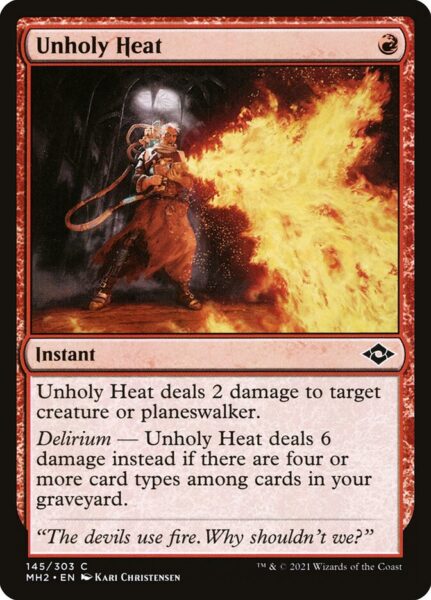
Frequent Decision Points
Our deck can be divided into three parts – 1-drop ramp spells (10), 3-drop Planeswalkers (8), and 5 drop dragons (9) – thereby ensuring as much consistency as possible in our opening 7. We want at least two lands, two mana dorks, 1 Planeswalker, and 1 dragon. The seventh card can be any one more of these, or one of our support cards, like Lightning Bolt. Once we know what we’re up against, we’ll know which cards we want to see and which we don’t. However, I will add a few comments on the kinds of decisions you will frequently have to make.
Turn 1 Utopia Sprawl or Arbor Elf?
Our most explosive turn 2 will come from a turn 1 Arbor Elf, but I almost always play Utopia Sprawl instead. The likelihood of Arbor Elf living through our opponent’s turn is not great and it is very important that we stick a 3-mana Planeswalker to stay on schedule. Either of our Walkers we then cast on turn 2 will allow us to play the Arbor Elf on turn 2, as well, which will set us up for a turn 3 dragon. Of course, if we have Questing Beast in hand, particularly with no turn 3 Planeswalker, then Arbor Elf is the correct turn 1 play. If we have a hand full of ramp and 1 or 2 dragons, then it is also correct to start with the elf, as it will surely draw out a kill spell if our opponent has one. We will continue ramping on turn 2 in order to play a dragon on turn 3 that will have a better chance of surviving now that our opponent has spent a kill spell on our Arbor Elf.
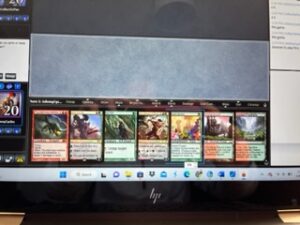
Turn 2 Kiora or Domri?
Against the Izzet decks, even if we are on the play, there’s a good chance our Planeswalker will get countered, either by Spell Pierce or Counterspell, if we are on the draw. If we have mana dorks in hand, it is often best to run these out instead. If we have Glorybringer, then we probably want Kiora to stick, as the dragon answers all of their 1-drop threats, at which point, we can bait out their counter with Domri. Otherwise, Domri protects our threats from later counters and so is one of our most important cards against them.
Against non-counterspell, creature-based decks, Domri gives us the ability to snipe some of their threats and so is often the correct play. Against the unfair decks, we typically want to be as fast as possible, in which case Kiora is our best option. It should be noted that a turn 1 Utopia Sprawl, into a second land and a Domri, does not set us up for a turn 3 dragon without a third land. Kiora in this scenario does, so keep that in mind when making your decision.
Glorybringer or Stormbreath?
The board state should make this decision pretty easy. With Kiora out and against creature decks, Glorybringer is almost always the correct play. Against decks relying heavily on white removal, Stormbreath Dragon will be the correct choice.
Turn 2 Field of Ruin or Planeswalker?
We play 4 Field of Ruin, 1 Boseiju, Who Endures, and 3 Wrenn and Six, which means we will often find ourselves with the ability to blow up one of our opponent’s lands on turn 2. When we’re lucky, we will get to repeat the process on turns 3 and 4. Against Tron, this is almost always the correct line of play. Against 4-color Money Pile and other decks with a greedy mana base, it’s a bit trickier. If you don’t have a dragon to play on turn 3, then it is probably the correct play to attack your opponent’s land and hope to keep them from playing Magic.
Urza’s Saga is a must-answer threat and, unfortunately, we have to almost always take a turn off to kill it if we have Field of Ruin. This can be a particularly painful decision when we have a fast, aggressive start, but odds are, we will lose to the Constructs before we will be able to close out the game.
Other Directions
As I mentioned above, there are several powerful cards we can make room for, all of which will bring new angles of play to the deck. The first is adding a playset of Ragavan, Nimble Pilferer. Here’s one way to make room for the stupid monkey.
-2 Wrenn and Six
-1 Ignoble Hierarch
-1 Thundermaw Hellkite
+4 Ragavan, Nimble Pilferer
The benefits of Ragavan should be obvious to anyone who has played with it or against it, but I’ll add a few thoughts about how it fits in a dragon deck. A turn 1 Ragavan is a must-answer threat, which means the chances our mana dorks stay alive are greater. Since our game plan remains ramping into a turn 3 dragon, baiting out a kill spell with Ragavan is perfectly acceptable. If our opponent has no answer, then the monkey can run away with the game all by itself, while we can still play mana dorks and dragons. Furthermore, the treasure tokens Ragavan produces will function as ramp, in so much as they will still allow us to cast a turn 3 dragon with just two hits from the monkey and no mana dorks. Finally, Ragavan is good in both the early and late game, whereas 3 of the 4 cards we are cutting to make room for it oftentimes are not.
With Ragavan in the lineup, we must take into consideration our suite of turn 1 mana dorks. A turn 1 monkey, followed by two Hierarchs on turn 2 means Ragavan is hitting for 4 damage. Since playing the full set of both Noble Hierarch and Ignoble Hierarch is already a viable build for this deck, the addition of Ragavan, Nimble Pilferer leads me to think cutting Arbor Elf in favor of Noble Hierarch is the correct choice.
-4 Arbor Elf
-1 Utopia Sprawl
-1 Questing Beast
-2 Wrenn and Six
-1 Thundermaw Hellkite
+4 Noble Hierarch
+1 Ignoble Hierarch
+4 Ragavan, Nimble Pilferer
With the addition of Ragavan and the Treasure tokens it makes, Goldspan Dragon becomes more attractive to play. However, this Gruul build of dragons is not optimized to take advantage of the double mana Treasures produced with the big flier the way my Izzet deck is.
I have played with Ragavan, Nimble Pilferer in my dragon deck quite a lot, and there is one line of play that comes up pretty often that deserves highlighting. A turn 1 Utopia Sprawl followed up by a turn 2 Kiora, Behemoth Beckoner allows us to dash in Ragavan, Nimble Pilferer on turn 2 while still staying on track to cast a turn 3 dragon. More frequently, however, we cast a turn 1 mana dork on the play, our opponent kills it on their turn, and we dash in Ragavan on turn 2. The Treasure we get allows us to cast another mana dork or to ramp into a dragon later. Finally, another frequent line of play is casting Ragavan, Nimble Pilferer off a turn 2 Domri, Anarch of Bolas. The card synergizes surprisingly well with our deck and, if it’s within your budget, should be tested.
Notes from Matches Played
If you’re reading this and there isn’t video of actual game play posted, congratulations on being one of the first to visit my site and read this article. This site is a work in progress and videos of this deck in action are on my to-do list. In the meantime, I took notes on the games I played and have a few pictures (yes, pictures, so enjoy the image of me in the background of some of them!) of common and/or interesting board states to go with them.
Match 1 – New 8-whack
Game 1
On the play…mull to 5. Couldn’t hit 5 mana or anything but dragons the whole game…
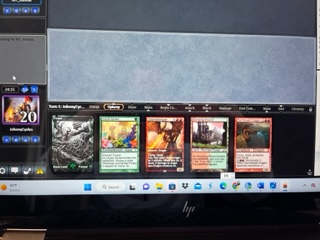
Game 2
Won on the back of a Chalice of the Void on 1, even though I played into it myself…oops.
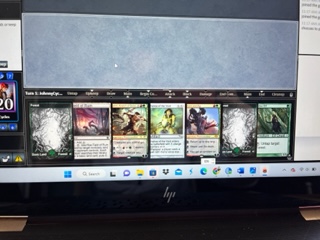
Game 3
Probably going to lose…but we’ll see. Opponent had a bad draw, I guess, and didn’t like the deck they were playing. Early scoop but probably correct.

2-1 for me.
Match 2 – New 8-whack deck…again
Game 1 – got run over, though I had a decent hand.

Game 2 – early scoop due to Chalice on 0. OP didn’t know I only had the one land but said they had a hand full of 0 drops.

Game 3 – had the hate, but couldn’t find any action and lost to 3 goblin tokens. Drew back-to-back lands, Utopia Sprawl, then Domri, then died.
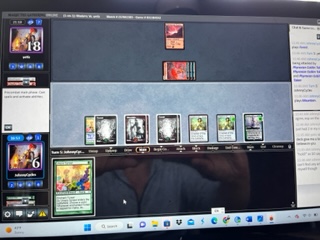
1-2.
Note: the match-up seems tough, though I didn’t draw that well and had to mulligan several times in multiple games. It’s a budget deck and unlikely to be too popular in leagues, but if it becomes the next big thing, adding one more sweeper in the board should be considered.
Match 3 – Jeskai Control
Game 1 – on the play, I stuck a Domri and ran them over with dragons. My hand and draw were amazing. Had them on the back foot the whole time, despite a turn 2 Chalice on 1 from OP. Had a Wrenn and Six ready to ultimate, a Domri, and cast Thundermaw Hellkite and 2 Glorybringer, with Questing Beast and a second Wrenn in hand.
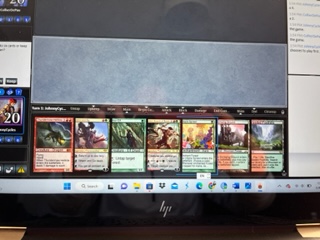
Game 2 – they scooped the match…I got the impression they didn’t want to play non-tier decks.
2-0
Match 4 – Hammer Time
Game 1 – stomped them with a fast start…turn 3 dragon, followed by turn 4 dragon. Used Wrenn, Bolt, and Glorybringer to keep the board clean.
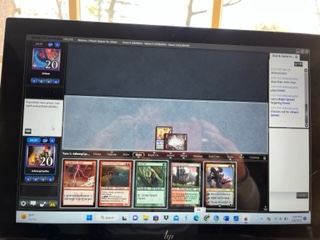
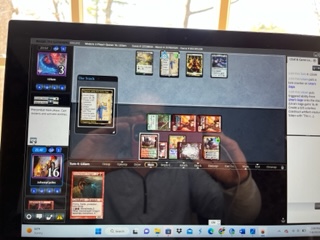
Game 2 – what a crazy game…OP had 3 Esper Sentinel but couldn’t find a hammer and I won the race with dragons. I drew hot fire to pull ahead, while OP did not. Definitely got lucky, but it feels good taking down one of the best decks in Modern.
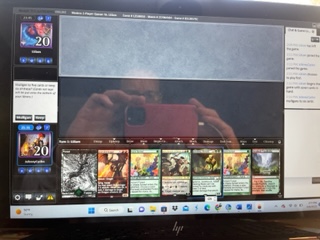
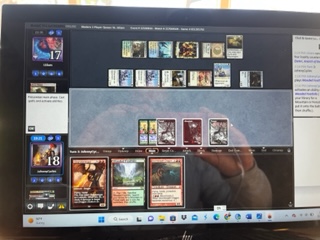
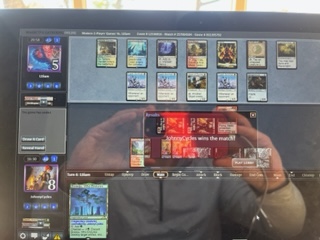
2-0
Match 5 – G/W Death and Taxes
Game 1 – shame scoop after failing to pay for his Stoneforge Mystic because of his own Leonin Arbiter…lol. Painful game, as death and taxes wants it to be and definitely got lucky with some of my draws, but this match feels winnable.
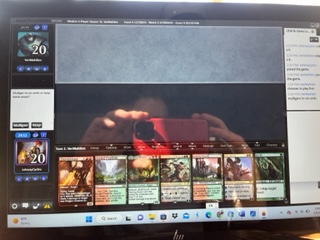
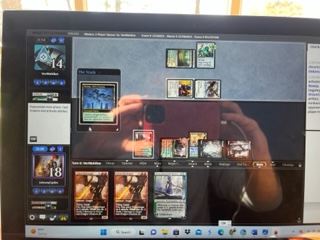
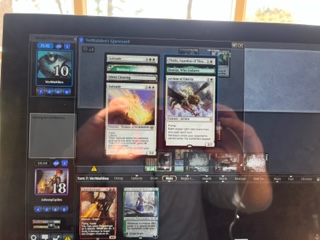
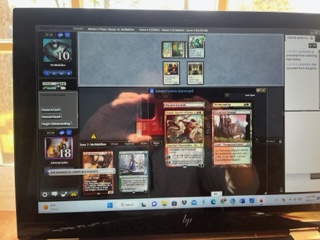
Fought through a lot of hate…only to have them shame scoop.
Game 2 – what a game! Turn 3 Kaldra Compleat and I still win. Some really tough decisions but I made the correct ones, it seems. Sniping their Mother of Runes to keep them from attacking through my Questing Beast and killing me was crucial. Them not swinging into my Questing Beast to kill Domri was also good for me. Also got lucky to hit the 4th land I needed. Questing Beast is the MVP, though Thundermaw Hellkite finished the game. Domri for value, too, was great. I barely had any removal and even thought of scooping upon resolution of Kaldra, but didn’t and they couldn’t find any more hate pieces to slow me down. At that point, I was able to keep up with Kaldra with attacks of my own to the point where they had to hold it back for blocking.
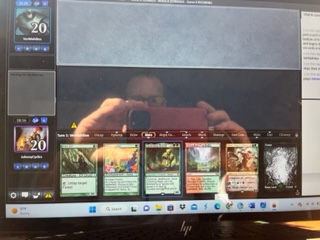
Mulligan to 6…pretty keepable hand.
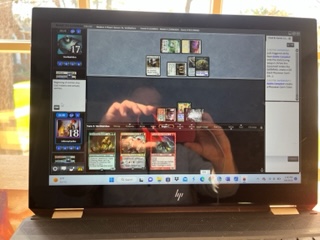
Turn 3 Kaldra on the play…
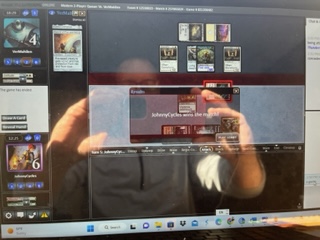
Questing Beast is the TRUTH!
2-0
Match 6 – Amulet Titan
Game 1 – on the draw. OP has a slow start at least. Lost when I used Domri to have my 6/5 Thundermaw Hellkite fight their Primeval Titan…only that removed all the loyalty counters from Domri, which meant my dragon was a 5/5. I had the Wrenn and Six to finish the Titan off, but had already used it. Given what I ended up drawing, I’m not sure it would’ve mattered. He played another Titan and used Valukut to kill me. I did draw a dragon in time to have had a chance I think, but it’s unclear. Still, lesson learned. Dragon to fight Domri, Wrenn to tick down and kill Titan. Next turn, they play a Titan. They untap with it and attack and get who knows what. I draw a Glorybringer. They were at 6. Wrenn would’ve put them at 5 on the turn before unless I got Field of Ruin back. I’m not sure. Would’ve been close. Tough loss to swallow against one of the best decks in the format.

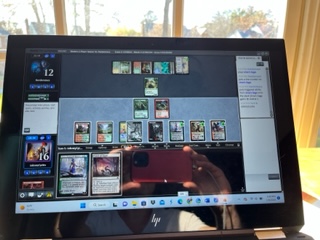
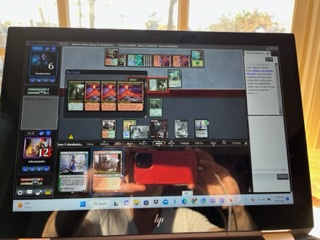
Game 2 – got there on the back of a turn 2 Kiora, followed by Stormbreath Dragon, Glorybringer, and Questing Beast. He killed the Stormbreath. Lesson – Stormbreath offered the most upside in that I could’ve made it monstrous on turn 4 and swung for lethal (OP had 7 cards in hand), but Glorybringer plus Kiora is very powerful in that spot as I can gun down any of OP’s threats except Titan. OP missed 5th land drop, which is crazy in a deck like that, but I guess even Amulet decks get mana screwed sometimes.
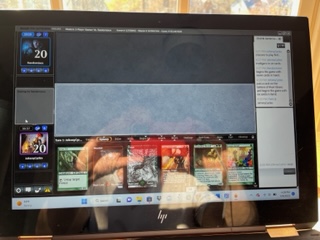
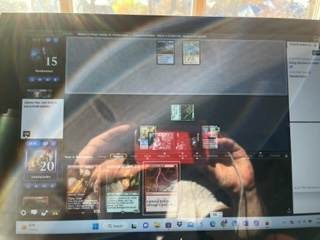
Game 3 – boarded out Brotherhood’s End, but forgot about Urza’s Saga from OP’s deck. Turn 3 Titan with an Amulet out…don’t think many decks are beating that, but certainly not mine. GGs. Another lesson learned – Tamiyo’s Safekeeping may give a Planeswalker indestructible, but if enough damage is done to it to remove all loyalty, it dies anyway.
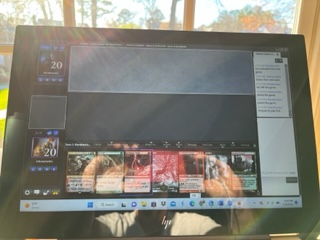
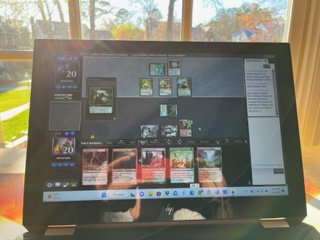
1-2
Note: I’ve played Amulet Titan several times now with this deck and I usually manage to get a game against it each time. The deck is just so fast and powerful. I’m not really sure what I’d bring in from the board to help, other than keep Brotherhood’s End in. I would’ve had a chance to blow up their Amulet after they attacked my Domri, assuming it was in my hand instead of the Tamiyo’s Safekeeping, which I brought in instead. That may have been enough, actually, to help me survive another few turns. Ending the day on a loss but with a 4-2 record. I learned some stuff about the Amulet Titan match-up, and my deck did some really fun and busted things. Too bad I misplayed in game 1. It may have cost me the match, given what I drew.
Match 7 – Devoted Druid combo
Game 1 – Luxior, Giada’s Gift plus druid = infinite mana. Walking Ballista = death.
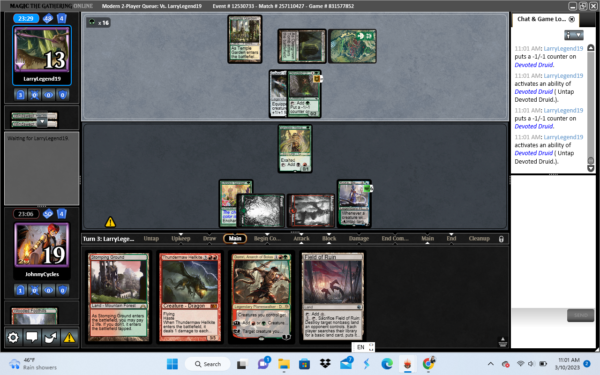
I figured out how to take screenshots!
Game 2 – another combo win…my deck has nothing to compete with what OP is doing. Attacked for approximately 100…
0-2
As always, thanks for reading! Let me know in the comments what you think of the deck. What dragons have I forgotten that saw competitive play over the years? Which dragons would you play in today’s Modern? What answers have you found for The One Ring? And, if you enjoy this kind of deck, be sure to read about my Gruul Superfriends Dragon deck! Next up: Rakdos Dragons!
